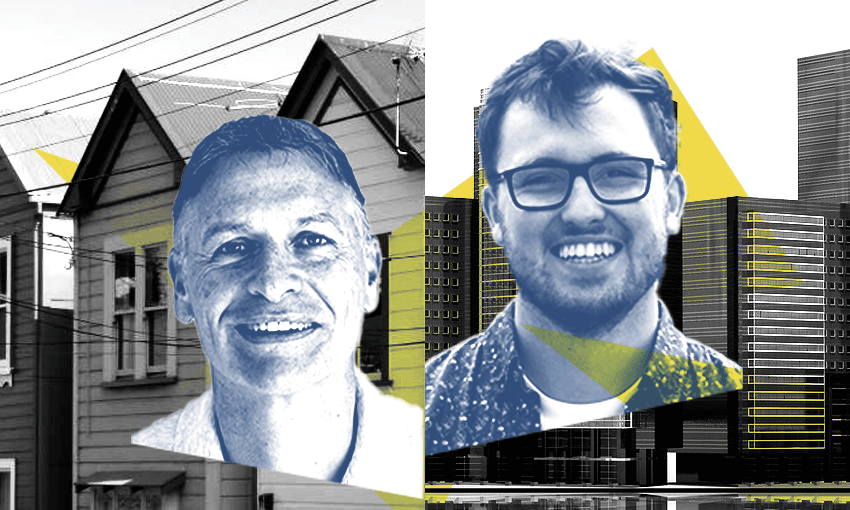The Lambton ward byelection wasn’t about left vs right, or even pipes vs bikes. It was a tussle between two amorphous political factions that have defined Wellington local body politics for decades.
The Pukehīnau/Lambton ward byelection was a thriller. Karl Tiefenbacher was declared the provisional winner on the first two ballots, only for Greens candidate Geordie Rogers to flip the result, with a 45-vote lead after special votes were counted.
Local politics often gets put into the framing of national politics. Media tries to wedge the candidates and positions into their parliamentary equivalent, but it never quite fits.
The race between Rogers and Tiefenbacher wasn’t about the Greens vs National. It wasn’t about left vs right. It wasn’t even about pipes vs bikes. More so than any recent election, it was a tussle between two amorphous factions that have defined Wellington local body politics for decades. For the sake of simplicity, let’s call them the New City and the Old Town.
The New City are the creatives, students, hipsters and yo-pros. They want to live an urbane lifestyle, with trendy cafes, thrift shops and experimental gigs. They look at Melbourne and Amsterdam with their trams, bike lanes and apartments, and aspire for Wellington to be like that.
The Old Town are long-time homeowners, deeply rooted in their community, who are uncomfortable with the way it is changing. They don’t want Wellington to become a big city – or think it would fail if it tried. They look at regional towns like Palmerston North or New Plymouth with their ample parking, wide roads, and quiet suburban neighbourhoods, and aspire for Wellington to be like that (while retaining the amenities of city life).
In central government politics, parties can at least claim they broadly want the same things, but just have different ideological ideas about how to get there. That isn’t the case here. The Old Town and the New City can’t negotiate, often can’t even communicate, because they have completely opposing goals.
The New City and the Old Town are not inherently left-wing or right-wing groups. There is a large left-leaning voter base in the Old Town, who support environmental causes and the arts, but are highly protective of character suburbs and skeptical of new developments. There’s also a right-wing faction of the New City, including the likes of Eric Crampton and the New Zealand Initiative, who want to rip away regulations and let developers build homes in a more free market environment, reducing rates by spreading costs across more households.
The Greens have opened up a dominance in Wellington’s local politics not because the city has suddenly veered towards socialism, but because they’ve managed to capture and champion the New City in a way Labour (and the right) never could.
Some local media took the closer-than-expected race as a sign of a Green backlash. I’d argue it’s the opposite. It shows just how strong the Greens – or more specifically, the New City, have become. Everything was against them: a low turnout byelection (which typically favours older voters), university students being away, their brightest star being replaced by an unknown newcomer, and the council being dogged with headlines about pipe failures, water restrictions and rising rates.
Geordie Rogers’ candidacy was frankly unremarkable, a cut-and-paste Green campaign. His posters, like his key policies, were generic and forgettable. His volunteer base didn’t hold a candle to the crowd Tamatha Paul drew, nor did he have the same social media firepower.
Meanwhile, Karl Tiefenbacher ran one of the most effective Old Town campaigns in recent memory. He’s a charismatic speaker who stuck to consistent messaging. He connected with his base, railing against bike lanes, the Golden Mile, and upzoning in the character suburbs. His campaign unified business and residential groups, was well-funded and organised, and his posters were by far the most visible of any candidate. Yet it still wasn’t enough.
In an interview on The Platform, Tiefenbacher – perhaps unintentionally – identified why the Old Town faction’s grip on Wellington is slipping: “If I lose this election it will be because 18-year-old students who have arrived in the last few days for O-Week have been inspired to vote in an election, when they probably will only be in Wellington for nine months or a couple of years for university, and have probably never paid any rates.”
The New City is outnumbering the Old Town, and it’s the students and young professionals who have tipped the balance. Every day there are more people pouring into Wellington, wanting to make a home for themselves.
The last time Wellington wrote its District Plan, the Old Town held an enormous amount of power, and used it to downzone and create character precincts, effectively blocking development in the inner suburbs. For a time, they managed to pause the city’s growth, or at least make sure it wasn’t in their backyard.
Geordie Rogers’ win means there are now eight Labour and Green votes on council, who will be expected to support more housing in the upcoming District Plan. At a minimum, it’s enough to tie 8-8 and give mayor Tory Whanau the casting vote, though there are a few centrist councillors who could swing on some or all of the amendments to give a stronger majority.
Does this mean Wellington is lost to the right? No. In fact, Whanau is electorally vulnerable right now. It’s easy to imagine a right-leaning candidate could unseat her in 2025 on a pro-development, pro-business platform. But that candidate would have to understand what that means in a real city with growing ambitions. It can’t just be complaining about car parks and bike lanes. They’d need to offer something for the New City.



